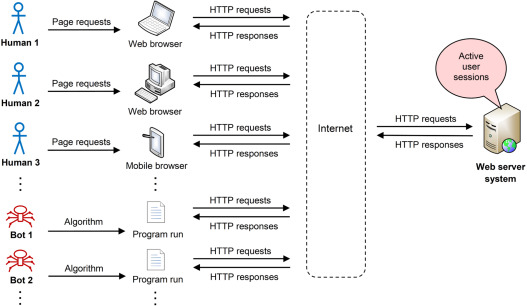Bot

A bot (or, more specifically, an Internet bot) is a computer program that performs automated tasks on top of a network (commonly the Internet).[2] Bots carry out repetitive and predefined tasks, often in a manner that mimics human behavior.[3] Due to their automated nature, bots can complete tasks more efficiently and at a larger scale than humans. Compared with other software applications, the time needed to develop and deploy bots (especially those that do not converse with online users) is relatively short.[2] Consequently, bots hold a significant presence on the Internet and power core components of the modern Web, such as search engines. In light of this ability, however, bots are frequently utilized to execute a variety of malicious activities.
Contents
History
Turing test
The notion of a bot dates back to 1950, when Alan Turing created the imitation game, later named the Turing test.[4] The test, or game, revolves around three players: two humans and one computer.[5] One of the human players, the interrogator, is isolated and inputs questions into a computer. The questions are structured in a particular format and a limited number are asked. The other human player and the computer player answer the questions asked. As the game proceeds, the interrogator uses the answers to determine which of the other players is the human and which is the computer. The computer player attempts to answer questions in a manner that imitates humans and is said to have passed the Turing test if the interrogator falsely concludes that it is the other human player. The computer player in this sense is thus seen as a representation of a bot.
Early bots
The computer player used in the Turing test closely resembles a chatbot, one that interacts with humans via dialogue.[6] Over the next few decades following the development of the Turing test, the development of chatbots grew significantly. During the 1960s, MIT professor Joseph Weizenbaum created ELIZA, a bot that utilizes natural language processing (NLP) to converse with humans. Overall, the original version of ELIZA was quite limited in terms of functionality and ability to hold conversations, but it is nevertheless remembered as being one of the first true instances of a bot.[4]
Following ELIZA, several chatbots emerged with varying behavior and oftentimes enhancements to preceding chatbots. These include PARRY (1972), Jabberwacky (1988), Dr. Sbaitso (1991), and ALICE (1995).[7] Many of the improvements made to chatbots over time are a result of advances in communication technologies and mechanisms, such as instant messaging (IM) and Internet Relay Chat (IRC).[8]
Web era
With the development of the Web, the usage and capabilities of bots expanded beyond chatting.[9] In particular, web crawlers, which are bots used by search engines to index web pages, arose during the 1990s. The first web crawler was developed in 1994 by Brian Pinkerton, a student at the University of Washington. Pinkerton’s web crawler led to the first search engine capable of text search, WebCrawler.[10] A few years later, in 1997, Google created its first web crawler, BackRub (now known as Googlebot).[9]
As the Web and Internet have grown, so have the roles and functions of bots. Bots are currently being used in several contexts, including online shopping, website monitoring, and social media.[3]
Design
Types of bots
Examples of bots
Traffic and management
Ethical concerns
See also
References
- ↑ Suchacka, G., & Iwański, J. (2020). Identifying legitimate web users and bots with different traffic profiles — An information bottleneck approach. Knowledge-Based Systems, 197, 3. https://doi.org/https://doi.org/10.1016/j.knosys.2020.105875
- ↑ 2.0 2.1 Cloudflare. (n.d.). How is an internet bot constructed? Cloudflare. Retrieved January 20, 2022, from https://www.cloudflare.com/learning/bots/how-is-an-internet-bot-constructed/
- ↑ 3.0 3.1 Kaspersky. (2021, March 22). What are bots? – Definition and explanation. Kaspersky. Retrieved January 20, 2022, from https://www.kaspersky.com/resource-center/definitions/what-are-bots
- ↑ 4.0 4.1 Zantal-Wiener, A. (2021, June 11). Where do bots come from? A brief history. HubSpot. Retrieved January 21, 2022, from https://blog.hubspot.com/marketing/where-do-bots-come-from
- ↑ Oppy, G., & Dowe, D. (2003, April 9). The Turing Test. In The Stanford Encyclopedia of Philosophy. Metaphysics Research Lab, Stanford University. Retrieved January 21, 2022, from https://plato.stanford.edu/entries/turing-test/
- ↑ Adamopoulou, E., & Moussiades, L. (2020). Chatbots: History, technology, and applications. Machine Learning with Applications, 2, 1–3. https://doi.org/https://doi.org/10.1016/j.mlwa.2020.100006
- ↑ Wood, D. (2020, August 28). What is the history of chatbots? YakBots. Retrieved January 21, 2022, from https://yakbots.com/what-is-the-history-of-chatbots/
- ↑ Gillis, A. S. (n.d.). Bot. In WhatIs.com dictionary. Retrieved January 21, 2022, from https://whatis.techtarget.com/definition/bot-robot
- ↑ 9.0 9.1 Knecht, T. (2021, May 4). A brief history of bots and how they've shaped the Internet today. Abusix. Retrieved January 21, 2022, from https://abusix.com/resources/botnets/a-brief-history-of-bots-and-how-theyve-shaped-the-internet-today/
- ↑ The History of SEO. (n.d.). Short history of early search engines. The History of SEO. Retrieved January 21, 2022, from https://www.thehistoryofseo.com/The-Industry/Short_History_of_Early_Search_Engines.aspx